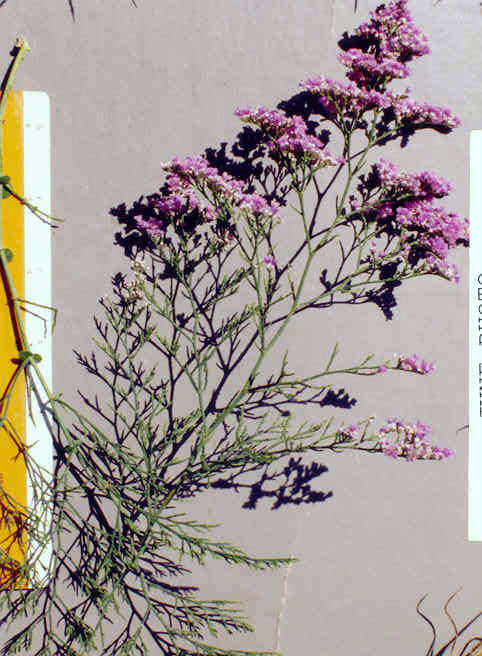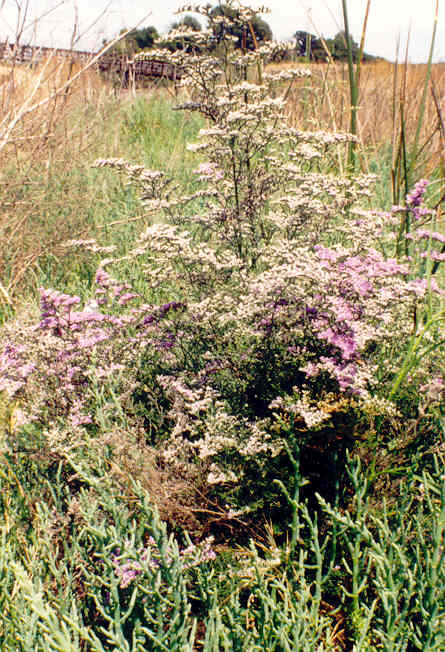
Limonium otolepis (Schrenk) Kuntze
 |
Limonium otolepis (Schrenk) Kuntze
Plumbaginaceae (Leadwort Family)West & Central AsiaLimonium |
June Photo
Plant Characteristics:
Perennial from a woody rhizome; lvs. in basal rosette dead before fls. appear;
blade 3-8 cm., 1.5-3 cm. wide, less than or greater than the petiole, obovate to
oblong, +/- entire, base tapered; lvs. on lower infl. axis less than 3 cm., +/-
round, sessile, clasping st.; infl.
40-80 cm.; branches slender, most without fls.; axes glabrous, not winged; calyx
tube +/- 1 mm., lobes +/- 0.5 mm. white, center rib red; corolla purple.
Habitat:
Uncommon. Disturbed, coastal, urban areas, especially salt marshes,
roadsides; less than 100 meters. San
Francisco Bay area; Los Angeles, Orange, Riverside, San Bernardino, San Diego,
Santa Barbara and Ventura counties.
Name:
Ancient Greek name, Leimonion,
supposedly from leimon, a marsh.
(Munz, Flora So. Calif. 637).
Greek, otos, ear and lepis, scale or scaly. (Jaeger
178, 139). Probably referring to
the ear-shaped leaves on the lower infl. axis.
(my comment).
General:
Rare in the study area with only one plant known and this on the westerly
side of the Delhi ditch where it terminates into the Upper Bay. This species is listed in the 1993 Jepson Manual, but no other text
that I have. The Jepson key says some infl. branches are without fls., the plant description says most are without
fls. My specimen has most infl.
branches with fls. This plant was found in 1997, by 2001, St. Augustine grass, Stenotaphrum
secundatum had choked the plant out of existence. (my comments).
Limonium perfoliatum, Kuntze
misapplied. (Hickman, Ed. 822).
About 150 species, world wide, often in saline soils.
(Hickman, Ed. 822).
Limonium is often used as dried
flowers. (Hickman, Ed. 822).
Statice is the old Latin name
for Limonium and is the common name of
the local cultivated variety. (John
Johnson).
Text Ref:
Hickman, Ed. 822.
Photo Ref:
April-June 97 # 24,31,32,33.
Identity: by R. De Ruff, confirmed by John Johnson.
First Found: May 1987.
Computer Ref: Plant Data 504.
Plant specimen donated to UC Riverside in 2004.
Last edit 8/7/05.
 |
June Photo